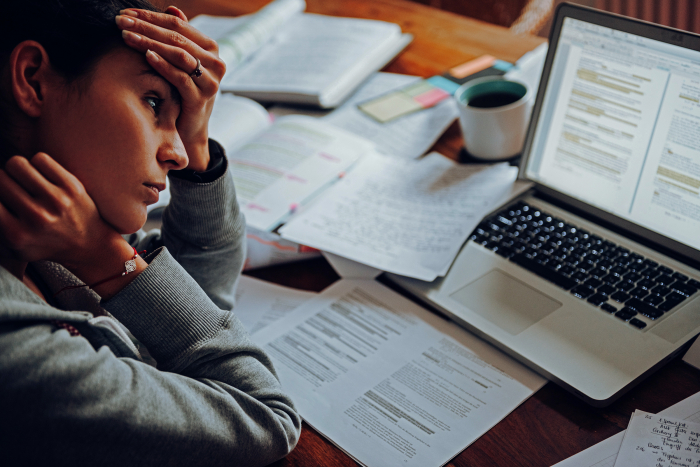Statistics show that stress and burnout are affecting more women than men en masse. Why – and what happens next?
When Jia, a Manhattan-based consultant, read Sheryl Sandberg’s bestselling book Lean In in 2014, she resolved to follow the advice espoused by the chief operating officer of Facebook.
“I’d just graduated from an Ivy League business school, was super pumped up and loved the idea of leaning in,” says Jia, whose last name is being withheld to protect her professional reputation. “Learning to self-promote felt so empowering, and I was 100% ready to prove that I was the woman who could have it all: be a high-powered career woman and a great mother.”
But today, the 38-year-old strikes a different tone. For years, she says, she feels like she’s been overlooked for promotions and pay rises at work on account of her gender, particularly after becoming a mother in 2018. Since then, she’s picked up the brunt of childcare responsibilities because her husband, who is a banker, has tended to travel more frequently for work. That, she adds, has given her a misguided reputation among her colleagues and managers – the majority of whom are male – for not being professionally driven.
Then when Covid-19 hit, it was as if all the factors already holding her back were supercharged. When her daughter’s day care closed in March 2020, Jia became the default caregiver while trying to stay afloat at work. “I was extremely unmotivated because I felt like I was spending all hours of the day trying not to fall off an accelerating treadmill,” she explains. “But at the same time, I felt like I was being trusted less and less to be able to do a good job. I could feel my career slipping through my fingers and there was absolutely nothing I could do about it.”
In early 2021, Jia’s therapist told her she was suffering from burnout. Jia says she’d never struggled with her mental health before. “But now I’m just trying to get through each week while staying sane,” she says.
Jia’s story is symptomatic of a deeply ingrained imbalance in society that the pandemic has both highlighted and exacerbated. For multiple reasons, women, particularly mothers, are still more likely than men to manage a more complex set of responsibilities on a daily basis – an often-unpredictable combination of unpaid domestic chores and paid professional work.
Though the mental strain of mastering this balancing act has been apparent for decades, Covid-19 has cast a particularly harsh light on the problem. Statistics show that stress and burnout are affecting more women than men, and particularly more working mothers than working fathers. This could have multiple impacts for the post-pandemic world of work, making it important that both companies and wider society find ways to reduce this imbalance.
Unequal demands
Recent data looking specifically at burnout in women is concerning. According to a survey by LinkedIn of almost 5,000 Americans, 74% of women said they were very or somewhat stressed for work-related reasons, compared with just 61% of employed male respondents.
A separate analysis from workplace-culture consultancy a Great Place to Work and health-care start-up Maven found that mothers in paid employment are 23% more likely to experience burnout than fathers in paid employment. An estimated 2.35 million working mothers in the US have suffered from burnout since the start of the pandemic, specifically “due to unequal demands of home and work”, the analysis showed.
Experts generally agree that there’s no single reason women burn out, but they widely acknowledge that the way societal structures and gender norms intersect plays a significant role. Workplace inequalities, for example, are inextricably linked to traditional gender roles.
In the US, women still earn an average of about 82 cents for each dollar earned by a man, and the gap across many countries in Europe is similar. Jia’s firm does not publish its gender pay-gap data, but she suspects that it’s significant. Moreover, she thinks many of her male peers earn more than her, something that causes her a huge amount of stress.
“The idea that I might be underselling myself is extremely frustrating, but I also don’t want to make myself unpopular by asking for more money when I’m already pushing the boundaries by asking my company to make accommodations for me having to care for my daughter,” she says. “It’s a constant internal battle.”
Research links lower incomes to higher stress levels and worse mental health in general. But several studies have also shown more specifically that incidences of burnout among women are greater because of differences in job conditions and the impact of gender on progression.
In 2018, researchers from University of Montreal published a study tracking 2,026 workers over the course of four years. The academics concluded that women were more vulnerable to burnout than men because women were less likely to be promoted than men, and therefore more likely to be in positions with less authority which can lead to increased stress and frustration. The researchers also found that women were more likely to head single-parent families, experience child-related strains, invest time in domestic tasks and have lower self-esteem – all things that can exacerbate burnout.
Nancy Beauregard, a professor at University of Montreal and one of the authors of that study, said that reflecting on her work back in 2018, it’s clear that Covid-19 has amplified the existing inequalities and imbalances that her team demonstrated through their research. “In terms of [the] sustainable development of the human capital of the workforce,” she says, “we’re not heading in a good direction.”
A pandemic catalyst
Brian Kropp, chief of human resources research at Gartner, a global research and advisory firm headquartered in Connecticut, US, agrees that while many of the factors fueling women’s burnout were in play before the pandemic, Covid-19 notably exacerbated some as it forced us to dramatically overhaul our living and working routines.
Structures supporting parents’ and carers’ lives closed down, and in most cases, this excess burden fell on women. One study, conducted by academics from Harvard University, Harvard Business School and London Business School, evaluated survey responses from 30,000 individuals around the world and found that women – especially mothers – had spent significantly more time on childcare and chores during Covid-19 than they did pre-pandemic, and that this was directly linked to lower wellbeing. Many women had already set themselves up as the default caregiver within their households, and the pandemic obliterated the support systems that had previously allowed them to balance paid employment and domestic work.
That’s exactly what Sarah experienced in March 2020, when schools across New York first closed. “Initially the message was that schools would stay closed until the end of April, so that was my target: ‘Get to that point and you’ll be fine’,” recalls the Brooklyn-based 40-year-old. Now, more than 18 months into the pandemic, her two sons, aged 6 and 9, are only just reacquainting themselves with in-person learning, and Sarah’s life has changed dramatically.
In April 2020, for the first time ever, she started suffering from anxiety. The pressures of home-schooling her children while working as marketing executive for a large technology company overwhelmed her. She couldn’t sleep, worried constantly and felt depressed. Worst of all, she felt like whatever she did was inadequate because she didn’t have enough time to do anything well.
Six months into the pandemic, it was clear something had to change. Sarah’s husband, a lawyer, was earning much more than her, and had done so since they got married in 2008. So, in August 2020 the couple jointly decided that Sarah would leave her job to become a stay-at-home mother. “Before this, I never really knew what being burned out meant,” she says. “Now I know beyond a shadow of a doubt.”
Sarah’s experience is emblematic of a much broader trend. In September last year, just as the pandemic was gaining pace, more than 860,000 women dropped out of the US workforce, compared with just over 200,000 men. One estimate put the number of mothers who had quit the US workforce between February and September last year at 900,000, and the number of fathers at 300,000.
As women lost crucial social lifelines during lockdown which may have been emotional and physical outlets for stress, it’s clear that the abrupt avalanche of extra domestic responsibilities pushed many who were already busily juggling home and work life further than they could go.
‘What’s the cost?’
One of the greatest concerns workplace experts harbour is that poor mental health among women in the workplace could discourage future generations from setting ambitious professional goals, particularly if they want to start a family. That could exacerbate the gender inequalities that already exist in terms of pay and seniority in the labour market.
Data indicate that this is indeed a legitimate concern; statistics collected by CNBC and polling company SurveyMonkey earlier this year showed that the number of women describing themselves as “very ambitious” in terms of their careers declined significantly during the pandemic. Data from the US Census Bureau shows that over the first 12 weeks of the pandemic, the percentage of mothers between the ages of 25 and 44 not working due to Covid-19-related childcare issues grew by 4.8 percentage points, compared to no increase for men in the same age group.
Equally, there are concerns about how new ways of working such as hybrid could impact on workplace gender equality. Research shows that women are more likely than men to work from home in a post-pandemic world, but there’s evidence that people who work from home are less likely to get promoted than those who have more face-time with managers. “Women are saying, I’m working just as hard and doing just as much, but because I’m working from home, I’m less likely to get promoted,” says Kropp. “That’s extremely demotivating.”
Dean Nicholson, head of adult therapy at London-based behavioural health clinic The Soke, suggests that perceptions of fairness – or otherwise – could impact on women’s workplace participation. “When the balance of justice is skewed against us in the workplace, then it's invariably going to lead to negative feelings, not just towards the organisation, but in the way that we feel about ourselves and the value of our contribution, as well as where we're positioned on a hierarchy of worth.”
To prevent an exodus of female talent, says Kropp, organisations must appreciate that old workplaces practices are no longer fit for purpose. Managers need to fundamentally rethink how companies must be structured in order to promote fairness and equality of opportunity, he says. That means pay equality and equal opportunities for promotion, as well as creating a culture of transparency where everyone – mothers, fathers and employees who are not parents – feels valued and can reach their professional potential while also accommodating what’s going on at home.
Steve Hatfield, global future of work leader for Deloitte, notes that mothers, especially those in senior leadership roles, are extremely important role models. “The ripple effect of what they’re seen to be experiencing right now has the potential to be truly profound on newer employees, and so it's up to organisations to prove that they can accommodate and cater to the needs of all employees,” he says.
As such, Hephzi Pemberton, founder of the Equality Group, a London-based consultancy that focuses on inclusion and diversity in the finance and technology industry, emphasises the need for managers to be trained formally and to understand that the initiative to create a workplace that’s fit for purpose must come from the employer rather than the employee. “That’s absolutely critical to avoid the risk of burnout,” she says.
But Jia, who says she’s now on the brink of quitting her job, insists that notable changes need to happen in the home as well as the workplace. “What’s become abundantly clear to me through the pandemic is that we all have a role to play in understanding the imbalances that are created when stereotypical gender roles are blindly adhered to,” she says. “Yes, of course it sometimes makes sense for a woman to be the default caregiver or to take a step back from paid work, but we need to appreciate at what cost. This is 2021. Sometimes I wonder if we’re in the 1950s.”
More about:
















































